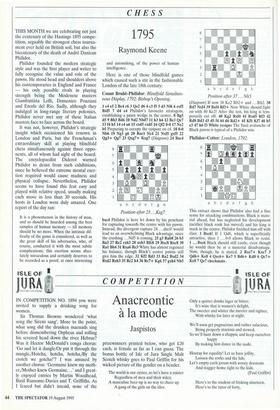CHESS
1795
Raymond Keene
THIS MONTH we are celebrating not just the centenary of the Hastings 1895 compe- tition, arguably the strongest chess tourna- ment ever held on British soil, but also the bicentenary of the death of Andre Danican Philidor.
Philidor founded the modern strategic style and was the first player and writer to fully recognise the value and role of the pawns. He stood head and shoulders above his contemporaries in England and France — his only possible rivals in playing strength being the Modenese masters Giambattista Lolli, Domenico Ponziani and Ercole del Rio. Sadly, although they indulged in long-range literary polemics, Philidor never met any of these Italian masters face to face across the board.
It was not, however, Philidor's strategic insight which occasioned his renown in London and Paris, but the Frenchman's extraordinary skill at playing blindfold chess simultaneously against three oppo- nents, all of whom had sight of the board. The encyclopaedist Diderot warned Philidor to desist from such exhibitions, since he believed the extreme mental exer- tion required would cause madness and physical collapse. Nevertheless, Philidor seems to have found this feat easy and played with relative speed, usually making each move in less than 30 seconds. His hosts in London were duly amazed. One report of the day ran:
It is a phenomenon in the history of man, and so should be hoarded among the best samples of human memory — till memory should be no more. When the intrinsic dif- ficulty of the game is considered, as well as the great skill of his adversaries, who, of course, conducted it with the most subtle complications; this exertion seems abso- lutely miraculous and certainly deserves to be recorded as a proof, at once interesting and astonishing, of the power of human intelligence.
Here is one of those blindfold games which caused such a stir in the fashionable London of the late 18th century: Count Bruhl–Philidor: Blindfold Simultan- eous Display, 1792; Bishop's Opening.
1 e4 e5 2 Bc4 c6 3 Qe2 d6 4 c3 15 5 d3 Nf6 6 exf5 Bxf5 7 d4 e4 Philidor's favourite stratagem, establishing a pawn wedge in the centre. 8 Bg5 d5 9 Bb3 Bd6 10 Nd2 Nbd7 11 h3 h6 12 Be3 Qe7 13 14 h5 14 c4 a6 15 cxd5 cxd5 16 Qf2 0-0 17 Ne2 b5 Preparing to occupy the outpost on c4. 18 0-0 Nb6 19 Ng3 g6 20 Racl Nc4 21 Nx15 gxf5 22 Qg3+ Qg7 23 Qxg7+ Kxg7 (Diagram) 24 Bxc4
Position after 23 ...Krg7
bxc4 Philidor is here let down by his penchant for capturing towards the centre with his pawns. Instead, the divergent capture 24 ... dxc4! would lead to an overwhelming Black advantage, since the crushing ... Nd5 is coming. 25 g3 Rab8 26 b3 Ba3 27 Rc2 cxb3 28 axb3 Rfc8 29 Rxc8 11xc8 30 Ral Bb4 31 Ftxa6 Rc3 White has almost regained his balance, though Black's centre pawns still give him the edge. 32 K12 Rd3 33 Ra2 Bxd2 34 Rxd2 Rxb3 35 Rc2 h4 36 Rc7+ ICg6 37 gx114 Nh5
Position after 37 ... Nh5
(Diagram) If now 38 Ke2 Rb2+ and ... Rh2. 38 Rd7 Nxf4 39 Bxf4 R13+ Now White should fight on with 40 Ke2! After the test, his king is tem- porarily cut off. 40 Kg2 Rxf4 41 Rxd5 Rf3 42 Rd8 Rd3 43 d5 f4 44 d6 Rd2+ 45 Kfl Kf7 46 h5 e3 47 h6 13 White resigns The final avalanche of Black pawns is typical of a Philidor win.
Philidor–Cotter: London, 1792.
This extract shows that Philidor also had a fine sense for attacking combinations. Black is mate- rial ahead, but has neglected his development (neither black rook has moved) and his king is stuck in the centre. Philidor finished him off with elan: 1 Bxc61 If 1 Qd6, which is superficially attractive, then 1 ... 0-0 allows Black to resist. 1 ... Bxc6 Black should still castle, even though he would then be at a material disadvantage. Now, though, he is mated. 2 1Rxe7+ Kxe7 3 Qd6+ Ke8 4 Qxc6+ Ke7 5 Bd6+ Kd8 6 Qc7+ Ke8 7 Qe7 checkmate.


















































 Previous page
Previous page